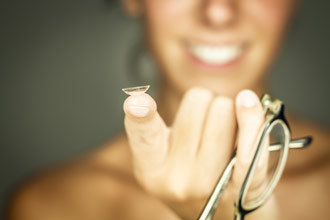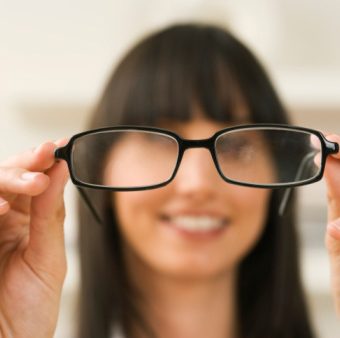I often get asked about whether someone can wear glasses for this or contacts for that. The answer is not always what people want to hear, but it has a lot to do with the prescription and what the activity is that the glasses or contacts are being used for. Both have their advantages and disadvantages. Depending on what a person values more will help determine what modality works better for them.
Glasses have not always been as fashionable as they are today. Thankfully, they come in all sorts of different shapes, colours, and materials to make wearing them more of an accessory than a necessity. As far as choosing glasses over contacts, it comes down to how well you want to see, what you need to be able to see, and what your prescription is.
 More often than not, glasses will provide clearer and sharper vision compared to contact lenses based on the fact that each pair of glasses is pretty much custom-made to order. Where as contact lenses are not custom-made (they manufacture powers in a range and whichever power you fall closest to is what your contact lens prescription is). Especially when it comes to higher powers and astigmatism, glasses will be better. As prescriptions get higher in contact lenses, there are only 0.50 steps in-between prescriptions versus the 0.25 steps for lower powers. For astigmatism, the minimum amount of prescribed astigmatism in contacts is -0.75, so if you have -0.25 or -0.50 astigmatism, it won’t be corrected in contacts (there is only minimal difference though). Depending on how sensitive you are to having the astigmatism corrected will determine if you notice having it versus not having it corrected in contact lenses.
More often than not, glasses will provide clearer and sharper vision compared to contact lenses based on the fact that each pair of glasses is pretty much custom-made to order. Where as contact lenses are not custom-made (they manufacture powers in a range and whichever power you fall closest to is what your contact lens prescription is). Especially when it comes to higher powers and astigmatism, glasses will be better. As prescriptions get higher in contact lenses, there are only 0.50 steps in-between prescriptions versus the 0.25 steps for lower powers. For astigmatism, the minimum amount of prescribed astigmatism in contacts is -0.75, so if you have -0.25 or -0.50 astigmatism, it won’t be corrected in contacts (there is only minimal difference though). Depending on how sensitive you are to having the astigmatism corrected will determine if you notice having it versus not having it corrected in contact lenses.
If you don’t require perfect vision, contact lenses may well be perfectly fine for your needs. Again, it comes down to what you need and not what the “norm” per se is. If you don’t require the sharpest vision and don’t mind having the astigmatism uncorrected then it’s fine not to have it corrected in contacts. There is often a comfort discrepancy when wearing regular spherical contact lenses and astigmatism lenses – the latter being bigger and less comfortable but sharper vision. My only recommendation would to not correct yourself only for near in contact lenses as with most near tasks, you are concentrating on a subject whether it be a screen or an object and in that act people tend to blink less than normal that will cause extra dryness. Most near tasks are better performed in glasses. If safety wear is also required, prescription safety wear would be better than wearing goggles over top of glasses or contact lenses.
 Depending on if you’re at the point in life where you need two different prescriptions for glasses and contacts will also determine which is better for you. Although the invention of multifocal contact lenses has improved the vision in contacts for users requiring both distance and near vision, it is still not up to par with progressives in the glasses department. They have come a long way and are still improving, but are not as good as a pair of digital progressives. I often suggest that people who are just starting to lose their reading try the multifocals (success rate is much higher in lower add powers). However, for people who require more power for reading, multifocal contact lenses are often not going to work too well. Monovision where one eye is corrected for distance and one eye for near is an option, but remember that you lose true depth perception because each eye is seeing a different image and not able to work together. I find the best option for most people that want to wear contacts at this age is to correct them for distance in contacts and have them purchase over-the-counter reading glasses to put on when they need to read. It’s the simplest solution without having to make any big changes to the type of contact lens their currently wearing.
Depending on if you’re at the point in life where you need two different prescriptions for glasses and contacts will also determine which is better for you. Although the invention of multifocal contact lenses has improved the vision in contacts for users requiring both distance and near vision, it is still not up to par with progressives in the glasses department. They have come a long way and are still improving, but are not as good as a pair of digital progressives. I often suggest that people who are just starting to lose their reading try the multifocals (success rate is much higher in lower add powers). However, for people who require more power for reading, multifocal contact lenses are often not going to work too well. Monovision where one eye is corrected for distance and one eye for near is an option, but remember that you lose true depth perception because each eye is seeing a different image and not able to work together. I find the best option for most people that want to wear contacts at this age is to correct them for distance in contacts and have them purchase over-the-counter reading glasses to put on when they need to read. It’s the simplest solution without having to make any big changes to the type of contact lens their currently wearing.
For health reasons, glasses will always be the better decision. Contact lenses are essentially a piece of plastic over the eye and restrict the amount of oxygen and nutrient transmission from tearfilm to cornea. Although there have been many advances in contact lens materials that are better than what they were, it is not at the point where wearing contact lenses is the same as wearing glasses – health wise. It is also easier on the eye muscles that are used for focusing (at near) to be to be focusing in glasses due to the optics that occur in contact lenses (more work in contact lenses). Also, currently it is only glasses that have the coatings to protect your eyes from the harmful blue light that is emit from all devices we use on a day to day basis.
My best advice for people is to usually wear glasses for majority of things and use contact lenses as a convenience for things like sports, working out, or going out. It is often mistaken that someone can wear contact lenses instead of glasses. The terminology is wrong. Contact lenses are more of an option when needed – they are not meant to replace glasses completely. The health concerns that arise with contact lenses is why contact lens wearers require eye exams more frequently (recommended once a year to ensure contacts are not causing damage to the eyes).
Personally, I use to over-wear contacts throughout my high-school, undergraduate, and graduate years (10 years total?). It wasn’t until I graduated from optometry and found glasses I actually liked to wear that I switched to wearing glasses more than contact lenses. It was just super-hard for me to find frames for my small face and high prescription (-6.50). Now I have multiple pairs of glasses and only wear contacts for physical activity and going out. I find my eyes are much more comfortable when I do wear contacts and they are less strained on a daily basis.



Personally, I prefer contacts when I exercise and then I use glasses in front of the tv/monitor.